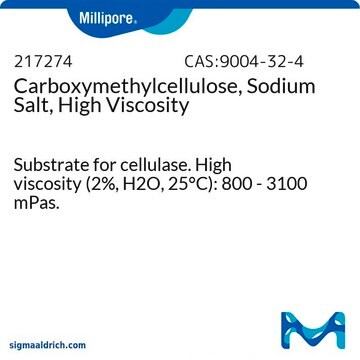C5678
Carboxymethylcellulose sodium salt
low viscosity
Sinônimo(s):
Sodium carboxymethylcellulose
About This Item
Produtos recomendados
fonte biológica
synthetic (organic)
forma
powder
cor
light yellow
faixa de pH útil
(20 °C, 10 g/L, 68 °F neutral)
viscosidade
50-200 cP, 4 % in H2O(25 °C)
pf
> 300.05 °C ((> 572.09 °F ))
solubilidade
water: soluble
traços de cátion
Na: 6.5-9.5%
temperatura de armazenamento
room temp
InChI
1S/C6H12O6.C2H4O2.Na/c7-1-3(9)5(11)6(12)4(10)2-8;1-2(3)4;/h1,3-6,8-12H,2H2;1H3,(H,3,4);
chave InChI
DPXJVFZANSGRMM-UHFFFAOYSA-N
Procurando produtos similares? Visita Guia de comparação de produtos
Descrição geral
Aplicação
Nota de preparo
Under normal conditions, the effect of temperature on solutions of this product is reversible, so slight temperature variation has no permanent effect on viscosity. However, long periods of heating CMC solutions at high temperatures (autoclaving) will degrade the product and permanently reduce viscosity. CMC is therefore very difficult to sterilize. γ-Irradiation, like heating, will degrade CMC. High viscosity CMC is more adversely affected by autoclaving and irradiation than is low viscosity CMC. Filtering CMC solutions tends to leave a gel behind because the material is fibrous, so solutions cannot be sterile filtered.
Outras notas
Código de classe de armazenamento
11 - Combustible Solids
Classe de risco de água (WGK)
WGK 1
Ponto de fulgor (°F)
Not applicable
Ponto de fulgor (°C)
Not applicable
Equipamento de proteção individual
Eyeshields, Gloves, type N95 (US)
Certificados de análise (COA)
Busque Certificados de análise (COA) digitando o Número do Lote do produto. Os números de lote e remessa podem ser encontrados no rótulo de um produto após a palavra “Lot” ou “Batch”.
Já possui este produto?
Encontre a documentação dos produtos que você adquiriu recentemente na biblioteca de documentos.
Os clientes também visualizaram
Nossa equipe de cientistas tem experiência em todas as áreas de pesquisa, incluindo Life Sciences, ciência de materiais, síntese química, cromatografia, química analítica e muitas outras.
Entre em contato com a assistência técnica

